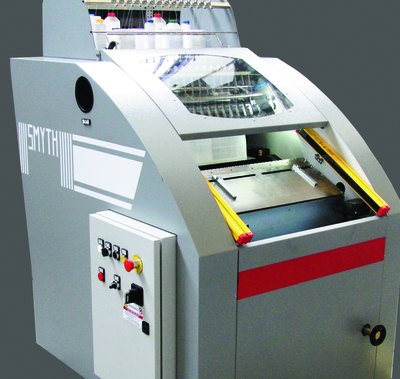The Smyth F55L can handle a 500 mm square signature
Quality-conscious buyers are looking to thread sewing once more for prestigious book work, causing renewed interest in machines such as Smyth’s section sewers.
They do say what goes around comes around, and in the case of thread sewing as a book finishing process that seems to be true. It was a victim of the PUR perfect binding wave a few years ago, but now smart binderies are turning to it again when looking for that niche finish. Bookbinders of London is a case in point.
Managing director Ian Bailey explained that the four generation-old family business moved away from section sewing to PUR because of convenience and because PUR was then itself a niche area.
‘That has been eroded because of the development of the kit and because more people are doing short run book binding inhouse.
We decided we needed to re-establishour niche in pure book binding, and for that you need to do section-sewn. That’s how a book should be bound. It is taking us back into a niche where the average digital printer will not go because it’s a skill set that they cannot easily acquire.’
The machine it invested in to make this move was the Smyth F3088 with Digital 88 front end feeder, a modular set up that enables Bookbinders of London to accept flat SRA3 sheets, even untrimmed, from a digital press, and fold and stitch them at up to 15 sections per minute. If the sheets are already folded into sections the Smyth can stitch 22 sections per minute.
Mr Bailey continued: ‘It is hugely attractive – we can almost do it for people while they wait and it doesn’t cost much more than a PUR book. Another thing that is very attractive is that we can sew a book with a spine lengthof more than 500 mm. There is a big buzz in the industry at the moment about layflat books, and you can buy some very expensive machinery that can do that. A properly bound book should open as a layflat book anyway, and this should appeal to agencies that just want 10 books. We can comfortably do that for a very good price.’
The company services most of the HP Indigo houses around London and is keen to work closely with those that have already invested in or are planning on investing in the B2 format HP Indigo 10000, since the Smyth section sewer can handle the over-sized sections these produce.
Worth the Wayte
A second Smyth sewing machine is up and running at Tunbridge Wells-based Wayte Binding, although this one is a semi-automatic F55L system and does not have the Digital 88 feeder. Instead, operators place folded sections directly onto the saddle by hand. This machine replaced an aging thread sewing machine in August 2013. A big attraction for Wayte was the fact that the F55L could handle a 500 mm square signature.
Owner John Wayte said: ‘It is a lot slower than the smaller machines but it can deal with much larger books, which is where our market is. It is ideally suitable for large books that others cannot handle, and it is hugely versatile because it can do smaller books too. Another advantage is that it is quick and easy to set up, and the wastage is minimal.’
He said the company decided against taking the digital feeder because it would lengthen the make ready. Mr Wayte was also concerned that this would limit the variety of sizes of book that could be thread sewn. ‘We need to be flexible in the sizes of books we can do. This is a relatively simple operation but we specialise in doing smaller numbers of highly variable books,’ he said.
As it is, the Smyth is sewing about 300 sections per hour. Both of these companies dealt with Perfect Bindery Solutions in investing in Smyth thread sewing, and both are gaining considerable interest from the market about the quality and format of book that they can now produce, not to mention the layflat character of these books.
‘There are customers out there that still remember what a properly bound book is,’ Ian Bailey emphasised. ‘Many have been a bit disillusioned about the move to perfect binding and case binding. We will continue with PUR but we are very positive that there’s a strong market for well bound books out there.
PUR will never open as flat as a section sewn book. You will lose the power of a spread and section sewing gives you that power.





